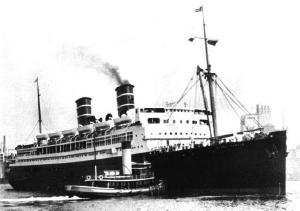 Morro Castle
| |
| History | |
|---|---|
| Name | Morro Castle |
| Namesake | Morro Castle |
| Owner | |
| Operator | |
| Route | New York City – Havana |
| Builder | Newport News Ship Building & Drydock Co., Newport News, Virginia, U.S. |
| Cost | US$4,000,000 |
| Yard number | 337 |
| Launched | 5 March 1930 |
| Completed | 15 August 1930 |
| Maiden voyage | 23 August 1930 |
| Out of service | 8 September 1934 |
| Homeport | New York City, New York, U.S. |
| Identification |
|
| Fate | Caught fire and beached herself on September 8, 1934; later towed off and sold to breakers (Union Shipbuilding Co.)[4] Scrapped[5] |
| General characteristics | |
| Tonnage | |
| Length | 480 ft 0 in (146.3 m)[6] |
| Beam | 70 ft 9 in (21.6 m)[6] |
| Depth | 18 ft 5 in (5.6 m)[6] |
| Installed power | 14,000 ihp |
| Propulsion |
|
| Speed | 20 knots (37 km/h) |
| Capacity | 489 passengers |
| Crew | 240 crew |
| Sensors and processing systems |
|
| Notes | sister ship: Oriente |
SS Morro Castle was an American ocean liner that caught fire and ran aground on the morning of September 8, 1934, en route from Havana, Cuba, to New York, New York, United States, with the loss of 137 passengers and crew.
On the previous evening, Morro Castle's captain, Robert Willmott, had died suddenly, and his place was taken by Chief Officer William Warms as a strong northeast wind was developing under heavy cloud. At 2:50am, a fire was detected in a storage locker, which burned through electrical cables, engulfed the ship in flames and plunged it into darkness. Responses by the crew, the United States Coast Guard and rescue vessels were notably slow and inefficient, with lifeboats not loaded to their capacity. The decks were too hot to stand on, smoke made breathing difficult and passengers were forced to leap into ocean swells where swimming was impossible. By mid-afternoon Morro Castle was abandoned and the survivors were landed on the shores of New Jersey by an assortment of craft.
The cause of the fire was never established, though an overheated funnel and certain points of cabin design and electrical circuitry were noted. A theory of arson by a crew member has attracted support over the years, albeit without any concrete evidence. The high casualties are chiefly blamed on the crew's incompetent handling of the emergency.
- ^ a b Lloyd's Register, Steamers and Motorships (PDF). London: Lloyd's Register. 1933. Retrieved October 11, 2020.
- ^ Lloyd's Register, Steamers and Motorships (PDF). London: Lloyd's Register. 1931. Retrieved October 11, 2020.
- ^ Lloyd's Register, Steamers & Motorships (PDF). London: Lloyd's Register. 1934. Retrieved May 20, 2013.
- ^ "Morro Castle Sold as Junk". The Gazette. Montreal. March 28, 1935.
- ^ "Morro Castle". GareMaritime.com. Archived from the original on June 30, 2011.
- ^ a b c d e Merchant Vessels of the United States. Washington, DC: United States Government Printing Office. 1931–1932.